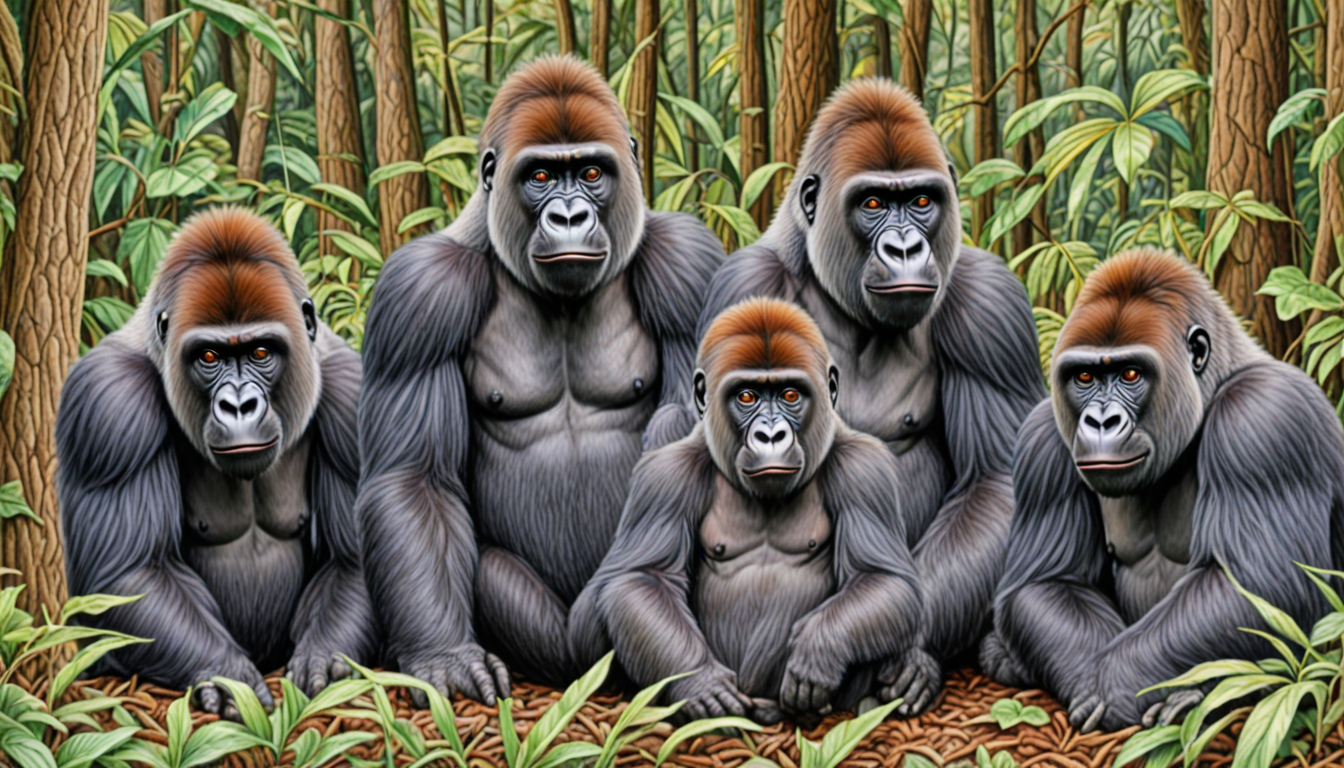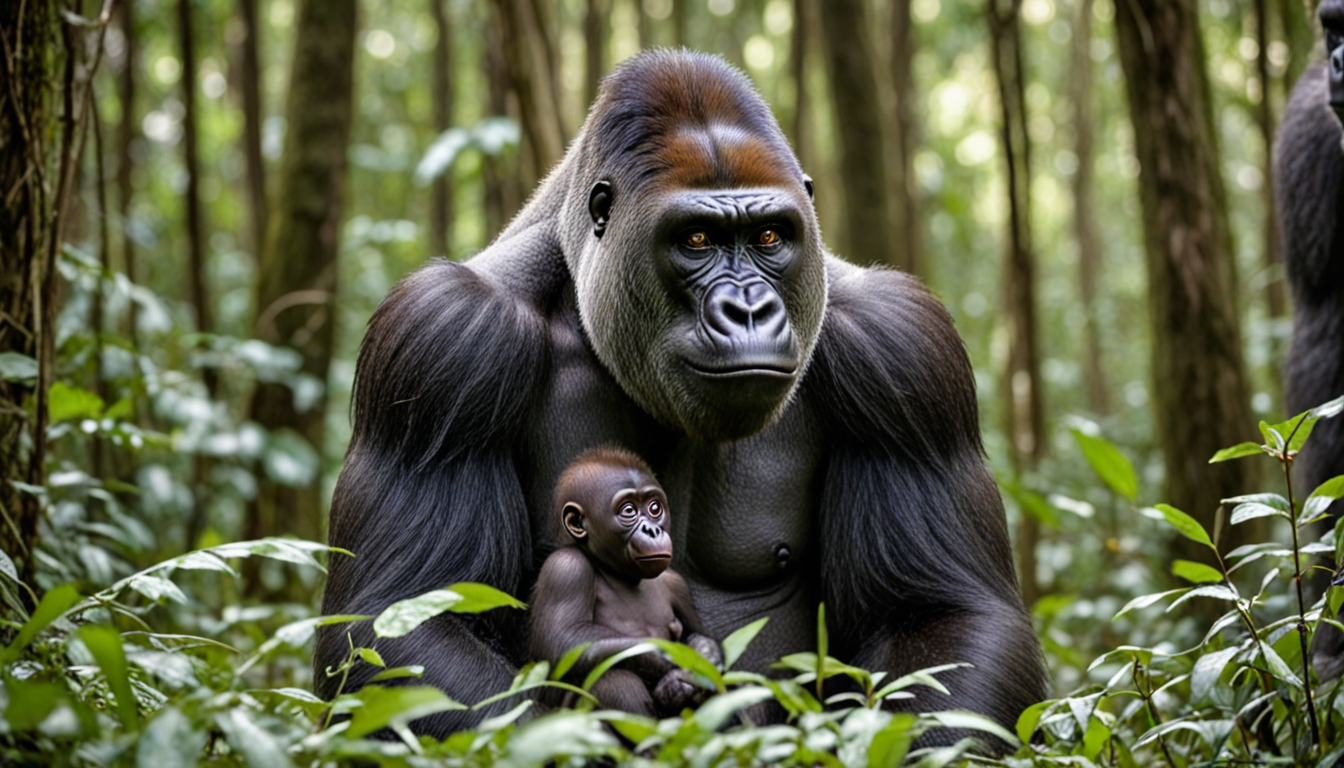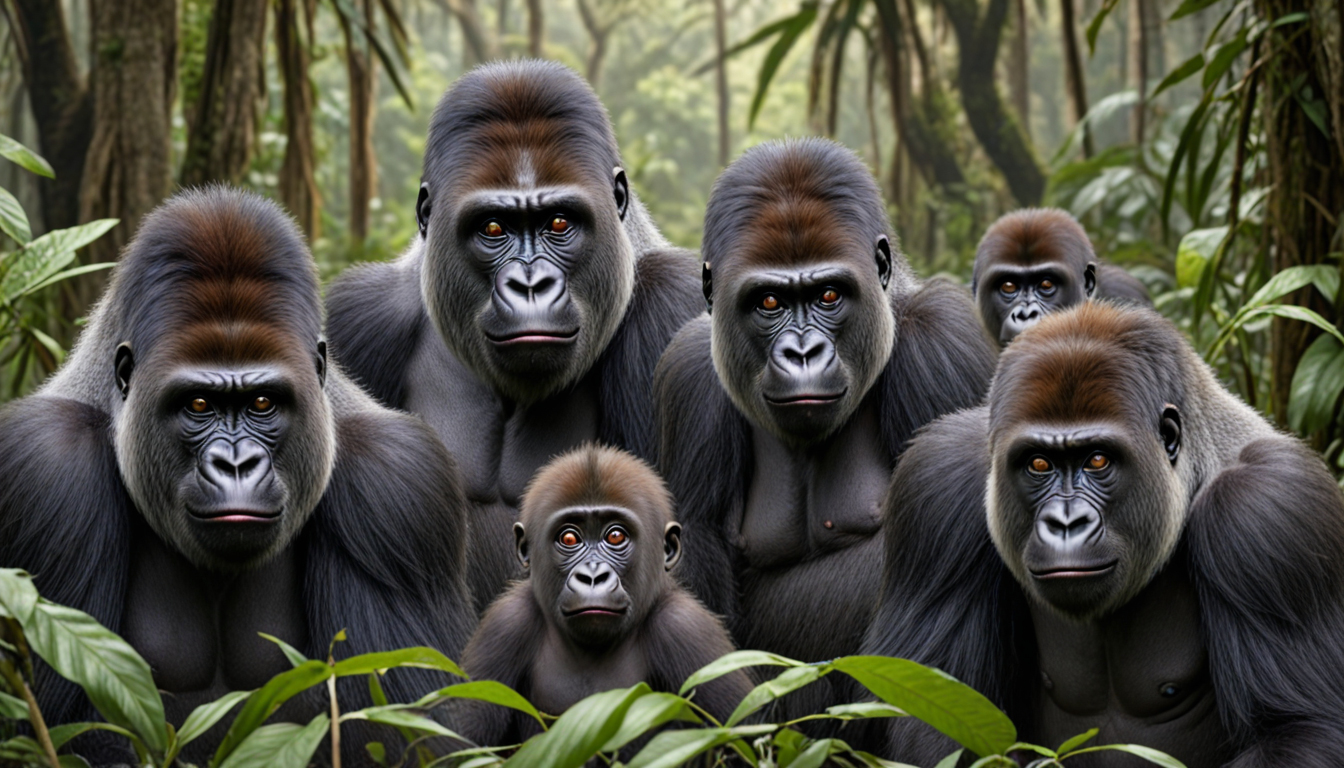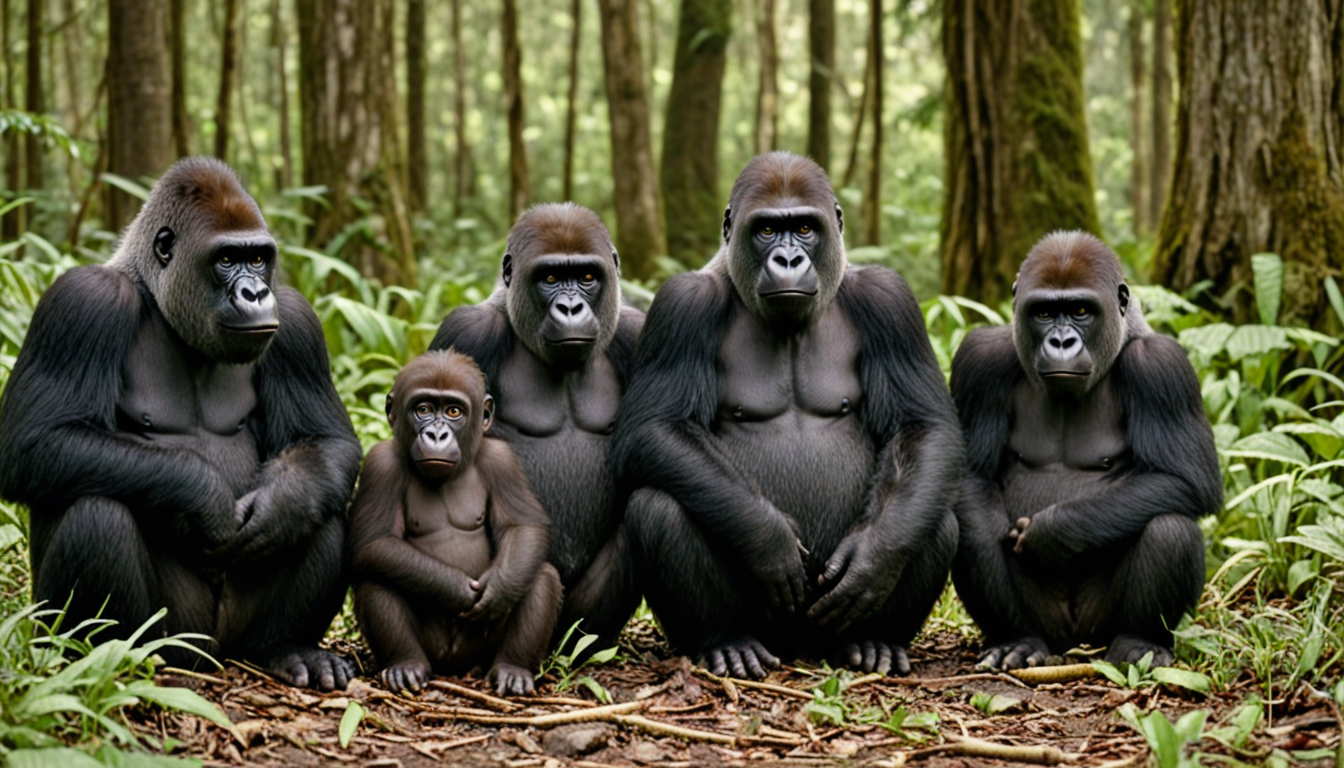In the dense rainforests where gorilla groups thrive, a silent and strategic battle unfolds daily. Understanding the complex dynamics of these societies is crucial, not only for the conservation of these species but also for gaining insights into the evolutionary forces that shape behavior. One of the most fascinating and, at times, brutal aspects of gorilla behavior is infanticide, where newly dominant or immigrated males kill dependent infants. This behavior, although harsh, is a strategy deeply rooted in the struggle for reproductive success and dominance.
Scientific research, particularly through game theory models, provides a lens to examine these behaviors. Game theory, a mathematical framework for strategizing interactions between different players, offers valuable insights into the mating strategies of gorillas and their consequences. By understanding these strategies, researchers can decode the fundamental processes behind reproductive decisions, revealing why certain behaviors, such as infanticide, occur despite their apparent brutality.
The game theory model developed by researchers simplifies the complex social interactions into a two-male, one-female system. Despite this simplification, the model provides profound insights into the strategies that both males and females employ to maximize their reproductive success. In this model, males have three pure strategies: attack (A), defend (D), and show indifference (I) towards offspring. Females, on the other hand, decide whether to mate exclusively with one male or distribute mating between two males. These decisions are influenced by various external parameters such as the probability of siring the next infant (m), the relative strength of the males (s), and the cost of defending an offspring (c).
By exploring the strategic choices of attack, defense, and indifference, we uncover the hidden mechanisms that drive these interactions and their implications for the stability and evolution of gorilla groups. This article delves into the findings from this comprehensive game theory model, explaining how males and females in gorilla societies navigate their complex social landscapes.

The sun had just begun to filter through the dense canopy of the forest, casting dappled light on the forest floor where a group of gorillas went about their morning routines. High above, the chatter of birds provided a soundtrack to the day, while the rustling leaves hinted at the secrets held within this lush landscape.
In the heart of this forest lived a troop of gorillas led by Baraka, the dominant male. Baraka was a formidable figure, his silver-backed fur a testament to his maturity and strength. His piercing eyes constantly scanned the surroundings, always alert to any threats to his position. For years, Baraka had maintained his rule through sheer force and strategic cunning, using every tool at his disposal to keep potential challengers at bay. One of his most ruthless strategies ensured that only his offspring would survive to adulthood, thereby cementing his legacy within the troop.
But change was in the air. Recently, a new male had arrived on the scene. Kito, younger and ambitious, had ventured into Baraka’s territory. With a strong physique and an insatiable drive, Kito represented a looming threat to Baraka’s dominance. He had watched from the periphery, learning the dynamics of the group, waiting for the right moment to challenge the established order.
Among the troop, there was another crucial player – Mara, a seasoned female whose decisions would shape the future of the group. Mara was respected and wise, having raised several offspring to maturity. She understood the stakes of the power struggle between Baraka and Kito. Her primary concern was the survival of her infants, and she had to navigate the dangerous waters of male rivalry with care. By mating with multiple males, she could create confusion about paternity, thus protecting her young from the threat of infanticide.
The forest itself was both a sanctuary and a battleground. Towering trees with thick, intertwined branches provided shelter and a complex network for the gorillas to traverse. On the ground, patches of sunlight illuminated clearings where the troop gathered, foraging for food and engaging in social activities. It was in these clearings that the true drama of their lives unfolded.

This particular morning, Baraka sensed the encroaching challenge. Kito’s presence had become more bold, and the older male knew a confrontation was inevitable. The troop, seemingly oblivious to the underlying tension, continued their routines, but the atmosphere was charged with anticipation. Mara watched from a distance, her mind already calculating the possible outcomes and her role in the unfolding events.
As the day progressed, Kito made his move, inching closer to the group, his posture assertive. Baraka noticed and let out a low, warning growl. The other gorillas paused, their instincts alerting them to the potential conflict. Mara, always observant, kept a close eye on both males, ready to act in the best interest of her offspring. In the dense forest, the stage was set for a strategic struggle that would determine the future of the troop. Each character, driven by their own motivations and instincts, played their part in this intricate dance of power, survival, and reproduction. The once peaceful forest now echoed with the sounds of power struggles and strategic maneuvers. Kito was no longer content to watch from the sidelines. He wanted to challenge Baraka and claim his place as the dominant male.
One morning, as the sun climbed higher in the sky, the inevitable confrontation began. Kito moved boldly into the heart of the troop’s territory, his muscles tensed and ready for the fight. Baraka, sensing the challenge, positioned himself between Kito and the rest of the group, his massive frame a clear signal of his readiness to defend his reign.
The troop members watched in anxious silence as the two males circled each other. Baraka made the first move, lunging at Kito with a fierce growl. Kito dodged and countered with a swift strike, his agility giving him an advantage over the older male. The forest was filled with the sounds of their struggle, a brutal dance of power and survival.
While the males battled for dominance, the females, led by Mara, had their own strategies to consider. Mara knew that the outcome of this fight would have significant implications for the troop and her offspring. She had seen Baraka’s ruthlessness firsthand; his strategy of infanticide had claimed the lives of many infants. Mara’s instinct to protect her young drove her to adopt a different approach.
By mating with multiple males, Mara created uncertainty about paternity. This confusion was a powerful tool in her strategy. If both Baraka and Kito believed they might be the father of her offspring, they would be less likely to harm the infants. This tactic required careful timing and subtlety, as Mara needed to balance her interactions with both males without provoking additional conflict.
As Baraka and Kito clashed, the rest of the troop remained on high alert. The females, observing the fight, began to position themselves strategically. Mara, in particular, watched closely, ready to act based on the outcome of the battle. She knew that her best chance of protecting her infants lay in leveraging the uncertainty of paternity.
Kito’s strategy in challenging Baraka was straightforward yet risky. He aimed to use his youth and strength to overpower the older male, thereby claiming dominance and ensuring his reproductive success. Baraka, on the other hand, relied on his experience and proven tactics of aggression to maintain control. His strategy was not just about winning the fight but also about reasserting his dominance through fear and intimidation.
After a prolonged and exhausting struggle, Kito managed to gain the upper hand. With a final, powerful move, he forced Baraka to submit. The older male, wounded and defeated, retreated to the outskirts of the troop’s territory. The forest fell silent once more as Kito stood tall, his new position as the dominant male established.
Mara watched the resolution with keen interest. She knew that the dynamics of the troop would change with Kito’s rise to power. Her strategy would need to adapt accordingly. She approached Kito cautiously, signaling her willingness to cooperate. By fostering a relationship with the new leader, Mara aimed to ensure the safety of her offspring and maintain her influence within the group.
As the troop settled into the new hierarchy, the subtle strategies of each member came into play. Kito, now the dominant male, had to secure his position and manage the threat of potential challengers. Mara and the other females continued their polyandrous mating tactics, using paternity confusion as a shield against infanticide.
The forest was quiet in the aftermath of the confrontation. The gorillas resumed their routines, but an air of anticipation lingered as everyone adjusted to the new dynamics. Kito moved with a new confidence, asserting his control over the troop. However, his victory over Baraka was only the beginning of his challenge. He had to secure his position against any future threats and prove himself as a leader.

Kito’s first test came sooner than expected. Baraka, though defeated, was not ready to disappear quietly. Nursing his wounds, he lingered on the outskirts of the territory, watching for an opportunity to reclaim his position. His presence was a constant reminder of the fragile nature of power within the troop.
One afternoon, as the troop rested in a sunlit clearing, Baraka made his move. He charged into the group with a force that took everyone by surprise. Kito, caught off guard, quickly gathered himself and met Baraka’s challenge. The two males clashed with renewed intensity, the stakes higher than ever.
The females, including Mara, watched the battle unfold. The outcome would determine the future stability of the troop and the safety of their offspring. Mara’s mind raced as she considered her next move. She needed to ensure that her strategy of polyandrous mating remained effective, regardless of who emerged victorious.
Kito, drawing on his youthful strength and determination, managed to fend off Baraka’s attacks. The older male, despite his experience, began to show signs of fatigue. Sensing an opportunity, Kito delivered a decisive blow, forcing Baraka to the ground. This time, the defeat was undeniable. Baraka, realizing his efforts were futile, retreated into the forest, his era of dominance conclusively ended.
The troop erupted into a mix of relief and acceptance. Kito had proven his strength and secured his place as the dominant male. He stood tall, surveying his domain, aware that maintaining his position would require constant vigilance and strategic alliances.
Mara, recognizing the shift in power, approached Kito with a calculated respect. She knew that forming a bond with the new leader was essential for the protection of her young. Kito, understanding the importance of Mara’s role within the group, reciprocated her gesture. Their interaction marked the beginning of a new alliance, one that would shape the future of the troop.
With Baraka gone, Kito began to implement his own strategies. He patrolled the territory, asserting his presence and deterring any potential challengers. The troop, now under his leadership, adapted to the new order. The younger males observed Kito’s actions closely, learning from his example as they prepared for their own future roles.
Mara continued her polyandrous mating practices, ensuring the paternity of her offspring remained uncertain. This strategy, while subtle, was highly effective. Kito, like Baraka before him, was less likely to harm infants that might be his own. The troop’s stability relied on this delicate balance, a testament to the intricate social strategies at play.
In the following months, the forest witnessed a period of relative peace. Kito’s leadership brought a new energy to the group, and the gorillas thrived under his rule. Mara’s offspring grew stronger, benefiting from the protection afforded by their uncertain parentage. The dynamics of power and survival continued to evolve, driven by the ever-present need to adapt and strategize.
With the dust settled and Kito now firmly in control, the troop’s daily life resumed under a new equilibrium. Yet, beneath the surface, the scientific principles governing their interactions continued to play out in subtle but profound ways.
Kito’s primary goal was straightforward: to ensure his lineage and maintain dominance. His aggressive challenge to Baraka and the subsequent victory were not merely acts of physical prowess but were deeply rooted in evolutionary strategies. By defeating Baraka, Kito increased his chances of siring the next generation, thereby passing on his genes. This ruthless calculus is a prime example of the game theory model in action, where individuals adopt strategies that maximize their reproductive success.
Baraka’s attempts to regain power were driven by the same evolutionary imperatives. Baraka’s infanticide strategy, though brutal, was designed to eliminate offspring that were not his, forcing the females back into estrus and providing him with another opportunity to sire his progeny. This behavior, while shocking to observe, is a stark illustration of the intense inter-sexual conflict described in scientific literature.
Mara’s role as the female protagonist added another layer of complexity. Her strategy of polyandrous mating was a sophisticated countermeasure to the males’ infanticide. By mating with multiple males, she created paternity confusion, making it less likely for any male to commit infanticide for fear of killing his own offspring. This strategy ensured the survival of her young, aligning her actions with the scientific findings that females in gorilla societies often adopt polyandry to protect their infants from infanticide.

As Kito settled into his role as the dominant male, he had to balance his aggressive tactics with the need to maintain troop cohesion. The females, including Mara, continued their subtle manipulations to ensure their offspring’s survival. The game theory model, with its focus on pure strategies and Nash Equilibria, explained these interactions perfectly. Each individual’s actions were a response to the strategies adopted by others, creating a dynamic yet stable social structure.
The external parameters, such as the probability of siring the next infant (m) and the relative strength of the males (s), played crucial roles in these interactions. For Kito, maintaining his dominance required not just physical strength but also strategic acumen. He needed to ensure that his chances of siring the next infant were maximized, which meant continuously asserting his dominance and deterring any potential rivals. This drive was encapsulated in the model’s parameter (m), representing the likelihood of a male siring offspring after committing infanticide.
For Mara, the key was to navigate these turbulent dynamics while ensuring her offspring’s survival. Her mixed mating strategy was her best response to the potential threat posed by infanticide. The game theory model’s prediction that females would receive the highest payoff in passive profiles (where neither male attacks) aligned perfectly with her actions. By fostering relationships with both Kito and other males, she maintained the ambiguity of paternity, thereby reducing the likelihood of her infants being targeted.
In the broader context, these individual strategies contributed to the overall stability of the troop. The game theory model, with its identification of Nash Equilibria, explained how these strategies, while seemingly self-serving, ultimately led to a balanced social structure. Each member of the troop played their part, driven by evolutionary imperatives to maximize their reproductive success while navigating the complex social dynamics.
As the troop settled into this new equilibrium, the relevance of the scientific research became strikingly clear. The game theory model, with its insights into strategies and outcomes, was vividly illustrated in the actions and decisions of Kito, Baraka, and Mara. Kito’s aggressive tactics and Baraka’s desperate defense highlighted the pure strategies of attack and defense, driven by the need to maximize reproductive success. Mara’s polyandrous strategy, creating paternity confusion, demonstrated the intricate balance of evolutionary tactics to ensure infant survival.
The Nash Equilibria predicted by the model, where each player’s strategy led to a stable outcome, were reflected in the new social structure of the troop. Kito’s dominance, reinforced by his victory, brought a period of relative peace and stability. The model’s prediction that females receive the highest payoff in passive profiles was evidenced by Mara’s continued success in protecting her offspring through strategic mating.
The research for this story came from the scientific paper: “Mating strategies in primates: A game theoretical approach to infanticide” by James E. Lyon, Sagar A. Pandit , Carel P. van Schaik , and Gauri R. Pradhan

